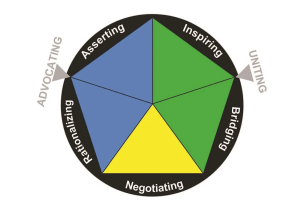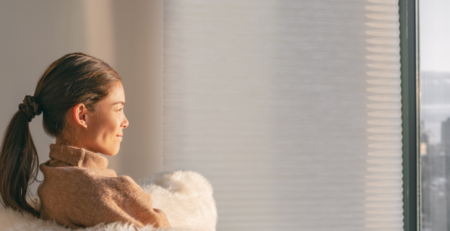Mastering Influence: Tailoring Your Style for Success
An individual’s ability to influence others plays a crucial role in shaping team dynamics and establishing clear organizational goals. Influence is the ability to affect other people’s ideas and behaviors; it is the ability to connect and inspire others. According to the Center for Creative Leadership, influencing others is a fundamental leadership skill required in roles in all levels of an organization.
Understanding Influence Styles
MHS’ Influence Style IndicatorTM (ISI) measures a person’s preferred style to influence others. The tool introduces five unique influencing styles: Rationalizing, Asserting, Negotiating, Inspiring, and Bridging. Understanding influence in this manner helps leaders understand their own influence style, how to recognize the styles of people they work with, and how to flex their style in different environments and improve their ability to connect with others.
The five styles are depicted in Figure 1 and can be summarized as:

- Rationalizing involves offering logical, rational reasons to influence others to accept your point of view.
- Asserting is insisting your ideas are heard and being open to challenging the ideas of others.
- Negotiating involves making compromises to reach outcomes that satisfy the greater interest.
- Inspiring involves motivating others with a sense of a shared mission and new possibilities.
- Bridging is based on building relationships and connecting with others.
We group Rationalizing and Asserting under the influence orientation of Advocating (see Figure 1). A person’s combined score in both influence styles can indicate that they are a strong advocate of their position in a situation and others can see that too. Some techniques individuals use with this orientation include:
- Logical reasoning
- Rational persuasion
- Use of relevant facts and data
Both Inspiring and Bridging are grouped under the influence orientation of Uniting (see Figure 1). A person’s combined score in both influence styles can indicate that they influence others to support them through a shared mission, perhaps shared excitement, and they can be perceived as a facilitator and motivator. Some techniques individuals use with this orientation include:
- Clarifying shared interest
- Building coalitions
- Understanding the positions and interests of others
While each influence style has its advantages and disadvantages, some are more effective than others in certain situations.
- Rationalizing can be best used when a person can offer their recognized expertise, or they are holding onto information that is not readily available to others.
- Negotiating is best used when power among individuals is equal and there is a mutual commitment to finding a solution.
- In Bridging, one will find success in a situation where they are open to collaboration and welcome information from others.
Samantha’s Story: Recognizing the Need for Adaptation
Consider this scenario: A team of marketing agency professionals working together in an open-concept creative office space. They collaborate to strategize and design creative collateral for a diverse roster of clientele. Samantha, their manager, is new to the team and she typically leads by asserting her position and expecting others to follow. She is firm, clear, and direct, and when a debate comes up, she is effective at getting her point across, even if others don’t agree. This style of influence, Asserting, has proven to be successful for her in situations at her previous roles, especially with regard to delegating work and meeting the demands of their clients. She delegates work and specifies project requirements without tolerance for pushback. She has felt comfortable challenging the opinions of her team members and ensuring everyone stays on track to meet deadlines. Samantha is confident relying on her assertive style; however, her confidence can make it difficult to recognize that a new style might suit her new team’s dynamic better.
In a recent meeting, team members shared with Samantha how her influence style has created challenges in the team’s dynamic. They expressed discomfort communicating their own ideas for improving processes and felt that overall team morale had dropped, resulting in feelings of disengagement.
Here’s why it’s important for Samantha to adapt her influence style to her team’s needs:
- Communication Challenges: In some situations, such as when there is a high need to get important issues resolved, Samantha’s assertiveness is beneficial. However, in other situations, such as brainstorming sessions, Samantha’s assertive style may come across as too directive and may lead team members not feeling comfortable sharing their opinions and ideas.
- Motivation and Engagement: Samantha’s style lends itself well to providing unwavering support of others. However, Samantha’s assertive approach may sometimes not be conducive to fostering motivation and a sense of camaraderie if the team feels their ideas are not being entirely heard.
- Flexibility and Adaptability: Samantha has always led in a very specific way. This fixed leadership style may not effectively address evolving challenges and opportunities at a creatively driven organization.
- Team Morale: Maintaining team morale and cohesion is essential. Samantha’s assertiveness may inadvertently erode team morale and cohesion, as she may be perceived as inflexible or overly controlling.
- Effective Leadership: Shifting her influence style to incorporate elements of collaboration, empathy, and flexibility can help Samantha better lead and support her team during high-stress situations.
Tailoring Your Approach
Following this feedback, Samantha had the opportunity to adjust her tactics and learned to rely on other skills to sway people to her side and make decisions collaboratively, rather than assertively. Samantha ultimately re-evaluated the way she influences her team’s work. In particular, she decided to improve on:
- Finding ways to involve her team in developing everyday workflow processes.
- Listening carefully in attempt to understand the needs and concerns of her team during individual and collaborative meetings.
- Recognizing and giving credit to team members for their contributions to finding solutions.
These actions are part of a Bridging influence style. Using a Bridging influence style at times, to balance her usual style of Asserting, she has become more flexible in her interactions with her team. Samantha shifted her daily focus to ensuring that her team has clarity on expectations, as well as feeling heard and included in the process. She seeks mutual understanding and encourages her team to ask questions, gaining trust in a new way.
Through employing a Bridging style when needed, Samantha is becoming a more flexible leader who is comfortable with handling the emotions of her team members. When faced with turbulent environments, changes in team dynamics, and rapidly changing markets, an influential leader will adapt their style and leadership strategies to maintain successful outcomes. However, Samantha’s preference for Asserting may prove useful in certain scenarios in the future, and she knows she can lean on that skill when it’s the right time to be directive and make decisions more quickly than her team can accomplish by consensus.
From Samantha’s scenario, we learn that mastering influence matters because being agile in your leadership approach and leveraging different influence styles as needed enables leaders to navigate situational complexities more successfully. Samantha’s story highlights the importance of understanding one’s influence style—its strengths and weaknesses—and how to adapt one’s style to face workplace realities.
Click here to build your influence toolkit and learn more about MHS’ Influence Style Indicator.
References
Center for Creative Leadership. (2020, November 24). 4 ways to strengthen your ability to influence
others. https://www.ccl.org/articles/leading-effectively-articles/4-keys-strengthen-ability-influence-others/










